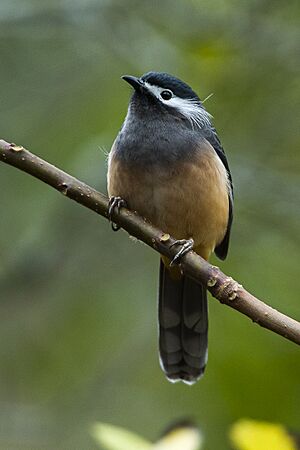White-eared sibia facts for kids
Quick facts for kids White-eared sibia |
|
|---|---|
 |
|
| Conservation status | |
| Scientific classification | |
| Genus: |
Heterophasia
|
| Species: |
auricularis
|
| Synonyms | |
|
|
The white-eared sibia (Heterophasia auricularis) is a beautiful bird that belongs to the Leiothrichidae family, also known as the laughingthrushes. This family includes many active and noisy birds. The white-eared sibia was first officially described by a scientist named Robert Swinhoe in 1864. It is the only species in its group, meaning there are no different types or subspecies of this bird.
Contents
Where Does the White-Eared Sibia Live?
The white-eared sibia lives only on the island of Taiwan. This means it is an endemic species, found nowhere else in the world! It makes its home in different kinds of forests and woodlands across the island.
Moving with the Seasons: A Partial Migrant
This bird is a "partial altitudinal migrant." This means that some white-eared sibias move up and down mountains depending on the season. During the summer, they breed high up, usually between 1,200 and 3,000 meters (about 3,900 to 9,800 feet) above sea level. In northern Taiwan, they can be found even higher, around 2,780 meters (about 9,100 feet).
When winter comes, some of these birds fly down to lower areas, sometimes as low as 700 meters (about 2,300 feet). If the weather gets very cold, they might even go down to 200 meters (about 650 feet). In summer, they prefer evergreen forests, which stay green all year. In winter, they might move to forests where trees lose their leaves.
What Does the White-Eared Sibia Look Like?
The white-eared sibia is a very elegant bird with a long tail. It measures about 22 to 24 centimeters (around 8.7 to 9.4 inches) long. It weighs about 40 to 50 grams (around 1.4 to 1.8 ounces).
Distinctive Features of the White-Eared Sibia
Its head is black, but it has a very noticeable white stripe that goes right through its eye. This stripe ends in long, delicate white feathers that look like plumes. The wings and tail are a deep blue-black color. You can also spot a clear white bar on its wings.
The upper part of its back and its chest are dark grey. Its belly and rump (the area above its tail) are a rich reddish-brown color, like chestnut. The bird's beak is black, and its legs are a brownish-flesh color. Both male and female white-eared sibias look the same. Scientists haven't yet described what young birds look like.
How Does the White-Eared Sibia Behave?
The white-eared sibia is a very active bird when it comes to finding food. It eats a wide variety of things!
What Does the White-Eared Sibia Eat?
It catches insects from flowers and also drinks nectar from them. Nectar is a sweet liquid found in flowers. It also enjoys eating acorns, berries, fruits, and seeds. The white-eared sibia has a special brush-like tongue that helps it drink nectar. However, it doesn't rely only on nectar for food.
Sometimes, it joins groups of Taiwan yuhina birds in flowering trees to get nectar when there's a lot available. Interestingly, it will also eat the eggs and baby birds of other species, including the Taiwan yuhina.
Where and How Does it Feed?
This bird can find food anywhere from the very tops of trees down to the forest floor. However, it usually prefers to feed higher up in the trees. It can be seen feeding alone, in pairs, or in small groups.
Breeding and Nesting Habits
Scientists don't know much about how the white-eared sibia raises its young. Even though the bird isn't shy, the only thing known is that it builds its nests high up in the canopy of tall trees.
Images for kids



